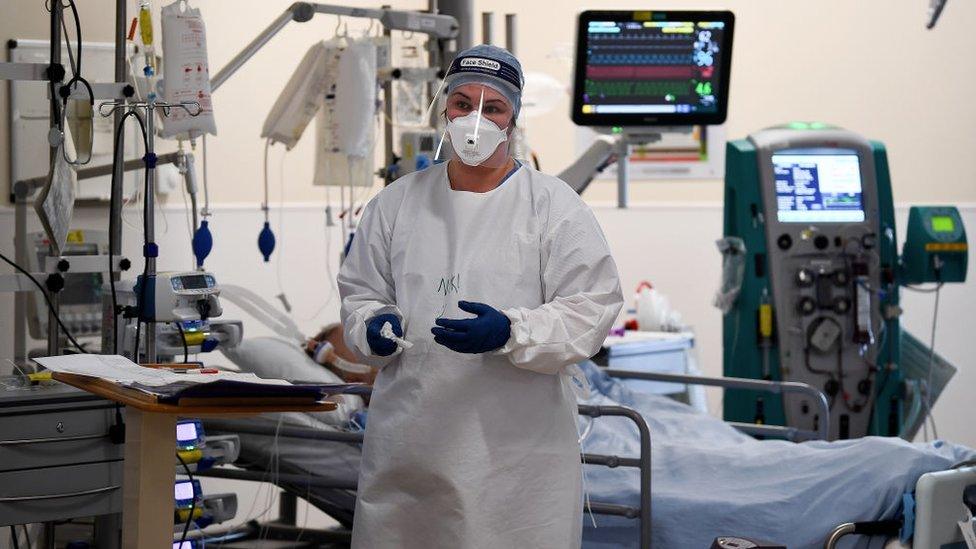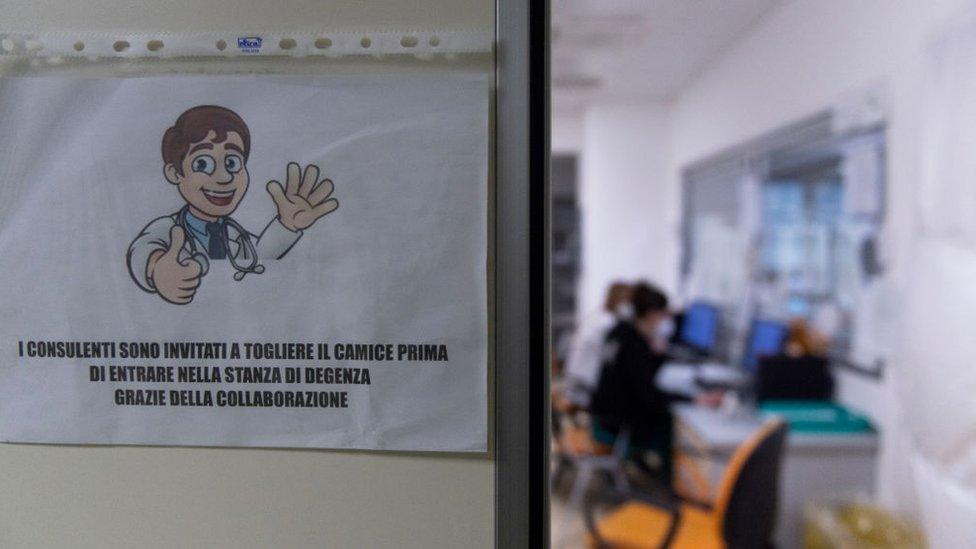NHS: In need of surgery or therapy?
- Published

Ideas for reform of the NHS and its funding are going public to challenge the political consensus that it can go on as it is.
Its problems cannot be solved by money alone - not while staffing is such a problem, and as demands on it keep rising. So would patient payments be a help or a betrayal of its core principles?
International comparison shows the NHS has relatively low management costs, but at a price of less flexibility, and some worse outcomes than comparable countries. Not many in Britain admit it, but perhaps there are lessons to be learned from the way other systems are funded.
The state of the NHS is forcing big questions of its leadership. In turn, its leaders are raising big questions about its sustainability, its future and its funding.
That's where the rest of us come in, because the health service belongs to us, as service users and voters. Its future is a shared responsibility.
The fact that the questions and some radical ideas for reform have made their way into the public domain gives us yet more evidence that the system is creaking, and there's frustration within top echelons of management that political leadership is not addressing the seriousness of the NHS's problems.
That's not just an issue for the Scottish government, as some have portrayed it. The consensus across parties and across governments at Holyrood and Westminster is that the NHS must be funded to do what we think it should be doing, even if the evidence suggests that may no longer be possible, if it ever was. And money can only be part of the solution.
Why? As public expectations of what the health service can do with the right medicine and procedures, it gets better and also more expensive. That's not what you find with most other sectors of the economy where the more you invest, the more you can innovate and you also drive down costs. Demographics also weigh heavily on it, and the link into social care.
Public spending watchdogs have been making the case for more substantial NHS reforms for years, or at least that the reforms intended should actually be delivered. Reports from Audit Scotland show exasperation that its warnings are not being heeded.
In February this year, it reported: "The NHS in Scotland is operating on an emergency footing and remains under severe pressure".
That reflected the huge challenge from Covid, with a build-up in the backlog of cases. And it went on to say: "The NHS was not financially sustainable before the pandemic and responding to Covid-19 has increased those pressures".
The backlogs remain, and budgets are tightening. The Auditor General returned to the theme of public service reform last week, for health, social care and beyond.
If you go further back, to just before the outbreak of Covid, the warnings were there about the slow progress on getting health and social care to work more closely together. Audit Scotland pointing out this journey began in 2005, and we're a long way from achieving what was intended.
In last week's autumn statement, social care reform in England was postponed yet again. Trying to avoid the need for people to sell their homes to pay for residential care is proving too expensive while the UK government budget is so tightly squeezed.
That issue remains only partly resolved in Scotland. And if the National Care Service is the solution, it's having a problematic start to life. It goes against one of the lessons from successful health systems elsewhere, which tend to have a strongly local or regional element, likely to make them more responsive to users' needs.
Workforce gaps
There's an economic case as well as a financial one. The whole economy suffers if there is poor health and an under-performing health service. There's been a sharp increase in the number of people who are not economically active and saying they have long-term illness.
That is partly due to long Covid, partly due to NHS waiting lists, and some of it less easily explained. But there is growing concern that poor health is a cause of poor productivity.
There's an impact on other public services. As the health service eats up an ever larger share of public spending, there is an impact on other public services; education, local government, policing, courts and prisons, the arts. On a constrained budget, they all suffer if the health service needs more and more resource in the hope of merely standing still.

There has been a big increase in people saying they have long-term illness, including long Covid
You could throw a lot of extra money at the NHS, and still find that it's not performing or even holding steady, because there aren't enough people to staff it.
There's a problem with workforce planning and with retention, some leaving because of the pressure of their jobs, some because of a pensions tax incentive for the highest paid NHS staff - mainly doctors - to retire earlier than we might wish them to.
The NHS loses professional, skilled staff to jobs overseas, and it is more restricted since Brexit in recruiting foreign staff people to fill vacancies.
There's an additional problem from that, highlighted again by Audit Scotland. It's not just that there are vacancies, and people not there when we need them, but that contributes to enormous pressure on the people who are there.
Coming out of the pandemic, the watchdog warned that these people need to be looked after, including their mental health, following a traumatic few years.
Queue jumpers
So could private contributions, from better off people, be part of the solution, as suggested in the draft minute seen by BBC Scotland?
Ministers swipe aside the suggestion. But the private sector is already part of the solution - easing the pressure on waiting lists.
If you've got an NHS waiting list for, say, hip replacements, there are a limited number of ways of getting that list down. You get more orthopaedic staff, if you can recruit them. Or you could get the ones you've got to work more efficiently. That could mean working through the weekend to make the most efficient use of scanning and operating theatres.
You can reduce waiting lists by, bluntly, people on them dying - and not necessarily because of that wait, but because people tend to die, eventually.
Or people can use their own resources to get the hip replacement done privately. That can be seen as unfair queue jumping. These are often NHS doctors who are working as private practitioners.
And if senior NHS managers were looking at an element of private funding - with the idea being discussed of better-off patients contributing towards their hip replacement - what do they get for that? Preferential treatment? Can they jump the queue? Better hospital food? You can see that being very unpopular.
In need of therapy
The issue may be less about public or private providers. The issue may be more about the use of patient funds, beyond tax funding, to manage demand.
That is, if people are asked to contribute £10 or £20 for a visit to the GP, or to the dentist, or returning to a fee for their prescriptions in Scotland, that should reduce demand. It cuts down on unnecessary consultations.
The problem then is: a £20 fee for a high earner is no problem, while it can be a large part of someone else's weekly budget. It may cut down on necessary consultations. A one-off prescription fee is easily handled. But several medicines for a chronic condition?
That appears to break our shared notion of what the NHS is there to do - health care provided when you need it, without having to worry about its cost. But that compromise came early in the NHS's history, with the introduction of prescription and dental charges in 1951. As things stand nearly 75 years on, many people have to pay big fees for dentistry, mental health therapy, physio or chiropractic treatment.
Those in need of social and nursing care routinely have to depend on unpaid carers. and not only to dig deep for self-funded care homes, but to subsidise those in neighbouring rooms whose fees from councils do not meet the costs. These are commonplace payments for basic health needs.
Continental co-payments
The international dimension is often overlooked in this debate. Every country's health needs profile is unique, the development of its health service is also unique and Scotland has particular health challenges.
A report from the OECD richer countries club concluded that no one system is superior, and moving between systems carries a high political cost, so it is not common to make big changes.
Where the NHS scores is in being relatively efficient, with lower management costs. But patient outcomes from the health service in Britain are not as good as they can be in comparable countries, including stroke or lung cancer survival rates.
So what can we learn from other countries? First, not to look at the United States. It has a very expensive system, shaped by industry lobbying, offering the very best care for those who can afford it, and poor quality or little care for many who cannot.
More useful comparisons are with closer neighbours or those with similar histories. There is always a tax element to fund at least a minimum level of support net for those without resources, sometimes directly linked and ring-fenced, though that can be problematic, and attempts to link British taxes that way have crumbled.

Italians pay nearly a fifth of their healthcare costs
Most have an element of user charging, varying from a fee per night spent in a German hospital, capped according to income, to a modest fee for visiting a New Zealand GP, to a wide variety of co-payments in Norway with an annual cap on out-of-pocket payments per head, to set fees in many countries, including England, that meet part of the cost of drug prescriptions.
Italian people pay around 18% of healthcare costs through user fees, with exemptions ranging across pregnant women to prisoners to pensioners, according to a King's Fund report in 2017.
It cited an OECD survey of 29 countries that found 20 of them have a fee for visiting a GP, half had a fee for hospital treatment, and all of them had a fee for prescriptions, which Scotland does not.
There's also a social insurance element across much of Europe, managed by governments, which working people, and often their employers, pay towards.
Unlike private insurance, that is not based on risk of illness, but on ability to pay, and unlike Britain, it makes an explicit link between payslip and healthcare. These do not all go direct to governments, but to social care insurers - heavily regulated, and when the system works, they're in competition to provide the best coverage.
Canada and Sweden are held up as examples of systems that work relatively well. The King's Fund think tank says Canadians meet 15% of costs out of their own funds, 12% from private insurance and more than 70% from general taxation.
Sweden has a large local component. In 2013, local taxes met 68% of costs from county council revenues, 18% came from subsidies and national government grants financed by national taxes.
There is so much more to health service reform than the source of funding. But just one of the differences that patients can expect in exchange for continental social insurance contributions is more choice than we are used to in Britain.
To have choice, there is a need for spare capacity, and that comes at a cost. Similar countries in Europe spend on average a fifth more per head on health, according to the Health Foundation. In Germany, it is nearly two-fifths more. Some of that goes on more administration.
Much of it goes on having more capacity. One of the features of the NHS is that it doesn't offer much choice of doctor or hospital, because there is not the excess capacity to allow that.
Its problems become far worse when demand surges to peaks which go beyond its capacity - usually in winter. But since the pandemic, that peak has become a plateau, all year round.
Related topics
- Published21 November 2022

- Published21 November 2022

